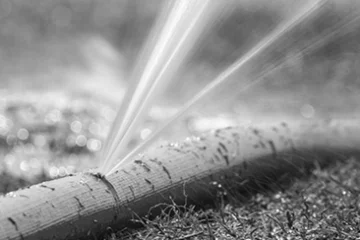Discovering orange tint in well water can be alarming. Orange Well Water is due to Iron present in water. Iron is the 2nd most abundant metal in earth crust, so it is common for iron to get into well water.
We will discuss causes, effects and treatment of orange well water.
Causes of Orange Well Water
There are following types of iron responsible for orange color of well water
1. Bacterial iron
Microorganisms like iron bacteria can oxidize ferrous iron, leading to the formation of orange colored precipitates.
Treatment
Use chlorine or hydrogen peroxide to disinfect the well and control bacterial growth. Install a chlorination or aeration system to oxidize and precipitate the iron, making it easier to filter.
2. Ferrous Iron (Fe2+)
Description: The presence of ferrous iron in well water contributes to its orange color.
Explanation: Ferrous iron is soluble in water and appears clear initially but reacts with oxygen, forming insoluble ferric hydroxide, which imparts the characteristic orange hue.
Cause: Dissolved oxygen reacts with naturally occurring iron in the ground, converting it to ferrous iron.
Treatment
Aeration: Allow the water to come in contact with air, promoting oxidation of ferrous iron to ferric iron, which can then be filtered.
Greensand or Birm Filters: These media can be used to filter out ferrous iron.
Water softeners with resin beds are effective in removing low to moderate levels of ferrous iron.
3. Ferric Iron (Fe3+)
Description: Ferric iron is another type responsible for the orange color in well water.
Explanation: When ferrous iron oxidizes, it transforms into ferric iron, creating visible particles of rust that give the water its orange or reddish tint.
Cause: Exposure of ferrous iron to air and oxygen leads to oxidation, forming ferric iron.
Treatment
Filtration: Use media filters, such as manganese dioxide-coated media, to trap ferric iron particles.
Polyphosphate Treatment: This sequesters iron, preventing it from precipitating and causing discoloration.
Treatment of orange color of well water
Treating orange well water involves addressing both physical and chemical aspects.
Physical Treatment
1. Filtration
Use sediment filters to remove visible particles, rust, and debris, improving water clarity.
2. Aeration
Introduce air to the water to oxidize dissolved iron and manganese, causing them to precipitate and become filterable.
Chemical Treatment
1. Chlorination
Chlorination involves adding chlorine to water for disinfection. This chemical treatment eliminates bacteria, viruses, and other pathogens, ensuring water safety for consumption.
2. Oxidation
Add oxidizing agents like chlorine or hydrogen peroxide to facilitate the precipitation of iron and manganese.
3. Acid Treatment
Acid treatment involves adjusting water pH using acids. This helps control alkalinity, prevent scale formation, and improve the efficiency of other water treatment processes, ensuring optimal conditions
4. Ion Exchange
Use specialized resins to exchange ions, removing unwanted minerals such as iron, manganese, and hardness.
5. Reverse Osmosis
Employ a membrane-based process to remove dissolved solids, ions, and contaminants at a molecular level.
Common Causes behind Orange Well Water
1. Rust in Orange Well Water
Rust in well water often results from the presence of iron, which can occur naturally in the ground. The oxidation of iron causes water discoloration, turning it orange. Solutions may include installing a sediment filter, water softener, or using oxidation filters to remove iron particles.
Treatment
Install a sediment filter, water softener, or oxidation filters to effectively remove iron particles from the water.
2. Well Infrastructure Issues
Issues with the well infrastructure, such as corroded pipes or well casing, can introduce contaminants into the water. Regular maintenance, inspection, and proper sealing of the well components can help prevent these problems and ensure clean water.
Treatment
Conduct regular maintenance, inspections, and ensure proper sealing of well components to prevent the introduction of contaminants. Address any corroded pipes or well casing promptly.
3. Tannins in Well Water
Tannins, those natural compounds found in well water, possess the ability to impart a subtle yet distinct hue of yellow or brown to the liquid. This is common in areas with high levels of organic matter. Filtration methods like activated carbon filters can effectively remove tannins, providing clearer and cleaner water.
Treatment
Use activated carbon filters for effective removal of tannins, addressing the organic compounds responsible for the yellow or brown tint in well water.
4. Corrosion of Well Components
Corrosion of well components, like pumps and pipes, can contribute to water quality issues. Using corrosion-resistant materials for well construction, regular inspections, and addressing corrosion promptly can mitigate this problem.
Treatment
Construct wells using corrosion-resistant materials, perform regular inspections, and promptly address any corrosion in components like pumps and pipes to maintain water quality.
5. Iron Oxidation
Iron oxidation occurs when ferrous iron transforms into ferric iron, leading to water discoloration. Aeration systems or chemical oxidation processes can be employed to facilitate iron removal, ensuring the water remains clear and free from rust-related issues.
Treatment
Employ aeration systems or chemical oxidation processes to facilitate the removal of iron caused by oxidation. This helps in keeping the water clear and free from rust-related discoloration.
Side Effects of Orange Well Water on Health
1. Neurological Symptoms
Presence of manganese in orange-tinted well water may result in neurological symptoms, including headaches, tremors, and cognitive dysfunction.
2. Bacterial Infections
Discolored water can be a sign of bacterial contamination, posing risks of infections and gastrointestinal disorders.
3. pH Imbalance
Changes in water color may indicate an imbalance in pH levels, affecting skin and eye health, and potentially causing irritation.
Conclusion
The orange tint in well water is caused by various types of iron, including bacterial iron, ferrous iron, and ferric iron. Treatment involves physical methods like filtration and aeration, as well as chemical approaches such as chlorination and oxidation. Common causes include rust, well infrastructure issues, tannins, corrosion, and iron oxidation. Health risks include neurological symptoms, bacterial infections, and pH imbalance. Treatment recommendations include using filters, softeners, oxidation filters, and addressing infrastructure issues promptly.
FAQs
What causes well water to turn orange?
Well water turns orange due to high iron content, typically in the form of iron oxide. Bacterial activity in the well can also contribute to the discoloration. Testing the water helps determine the exact cause and appropriate treatment methods.
How do you stop orange water?
To address orange well water, install a water filtration system designed for iron removal. Regularly maintain and clean the system to ensure effectiveness. Consult with a water treatment expert for tailored solutions based on your specific water quality.
Is orange well water safe?
Orange well water may indicate high iron content, but its safety depends on comprehensive testing. High iron levels can affect taste, stain fixtures, and, in excess, pose health risks. Consult with a water testing professional to assess and address any potential issues.





